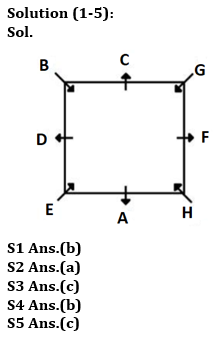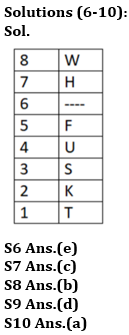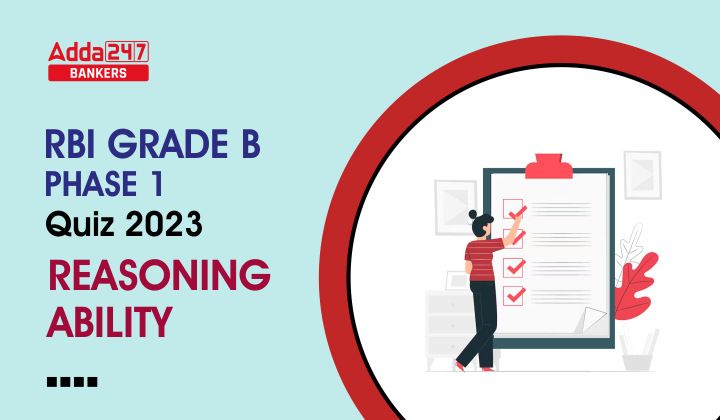Direction (1-5): Study the information carefully and answer the following questions.
Eight people i.e. A, B, C, D, E, F, G and H sit in a square shaped table but not necessarily in the same order. Four people sit at the four corners of the table and face inside the table. Four people sit at the middle of the four sides and face outside the table. B sits third to the right of A. E sits second to the right of B. One person sits between E and H. G sits second to the right of H. C sits second to the right of D who does not sit adjacent to G. F does not sit at the corner.
Q1. How many people sit between F and G when counted from left of F?
(a) One
(b) None
(c) Two
(d) Four
(e) Three
Q2. Who sits third to the right of B?
(a) A
(b) H
(c) E
(d) F
(e) None of these
Q3. Four of the following five are alike in a certain way and hence form a group. Find the one who does not belong to that group.
(a) G
(b) H
(c) D
(d) E
(e) B
Q4. How many people sit between F and B when counted from left of F?
(a) One
(b) Two
(c) Four
(d) None
(e) Three
Q5. Which of the following statements is true?
(a) C faces inside the table.
(b) G is neighbour of A.
(c) E faces G.
(d) H faces C
(e) All are true
Direction (6-10): Study the following data carefully and answer the questions accordingly.
Seven people live in an eight-story building. One person lives on one floor. The ground floor is numbered 1 and the top floor is numbered 8. One of the floors is vacant. There are six floors between T and W. Three people live between F and T. F does not live on an even-numbered floor. S lives below F but not immediately. Two people live between H and S. H does not live on an even-numbered floor. K lives below U.
Q6. Who lives immediately above F?
(a) S
(b) W
(c) The one, who lives below S
(d) H
(e) No one
Q7. U lives in which of the following floor?
(a) Sixth floor
(b) Fifth floor
(c) Fourth floor
(d) Third floor
(e) None of these
Q8. Which of the following floors is vacant?
(a) Seventh
(b) Sixth
(c) Fifth
(d) Fourth
(e) None of these
Q9. If all of them are arranged in alphabetical order from the top to the bottom at the occupied floors, then how many of them will remain at the same place?
(a) Three
(b) Two
(c) Four
(d) One
(e) None of these
Q10. Find the odd one.
(a) U, W
(b) F, S
(c) K, U
(d) S, T
(e) H, U
Directions (11-15): The following questions are based on the five three-digit numbers given below.
763 952 841 695 391
Q11. If all the digits in each of the numbers are arranged in increasing order within the number, then, which of the following number will become the lowest in the new arrangement of numbers?
(a) 391
(b) 695
(c) 763
(d) 841
(e) None of these
Q12. If all the numbers are arranged in ascending order from left to right then, which of the following will be the sum of all the three digits of the number which is 3rd from the right in the new arrangement?
(a) 18
(b) 16
(c) 14
(d) 11
(e) None of these
Q13. What will be the difference when the third digit of the 3rd lowest number is multiplied with the second digit of the highest number and third digit of the 2nd highest number is multiplied with the second digit of the lowest number?
(a) 4
(b) 8
(c) 9
(d) 5
(e) None of these
Q14. If the positions of the second and the third digits of each of the numbers are interchanged then, how many even numbers will be formed?
(a) None
(b) One
(c) Two
(d) Three
(e) Four
Q15. If one is subtracted to the second digit of each of the numbers and one is added to the third digit of each number then, how many numbers thus formed will be divisible by three in the new arrangement?
(a) None
(b) One
(c) Two
(d) Three
(e) Four
Solutions


Solutions (11-15):
S11.Ans (a)
S12.Ans (b)
S13.Ans (e)
S14.Ans(c)
S15.Ans (a)





 GA Capsule for SBI Clerk Mains 2025, Dow...
GA Capsule for SBI Clerk Mains 2025, Dow...
 The Hindu Review October 2022: Download ...
The Hindu Review October 2022: Download ...
 ECGC PO Cut off 2025 Out, Check Final Cu...
ECGC PO Cut off 2025 Out, Check Final Cu...




